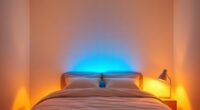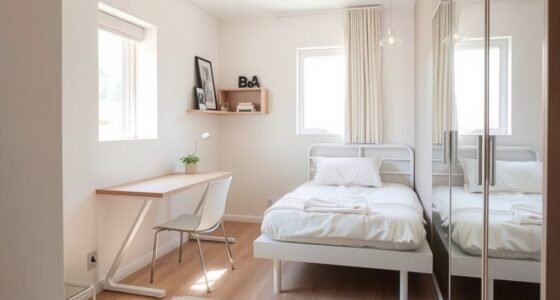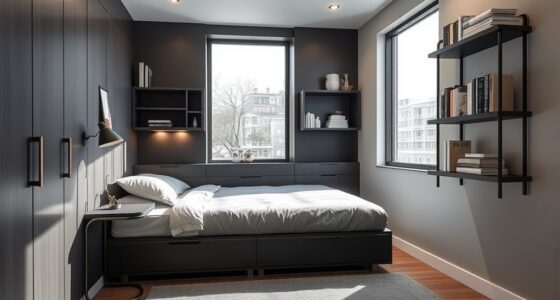Choosing warm neutrals for your bedroom creates a calming and cozy environment that helps you relax and fall asleep more easily. These colors evoke feelings of safety and stability, promoting restful sleep. In contrast, bold hues can energize your mind and might make it harder to unwind, especially if overused. To optimize your sleep space, balancing soothing tones with vibrant accents works best. Keep exploring to discover how to craft your ideal, sleep-friendly palette.
Key Takeaways
- Warm neutrals promote relaxation, calmness, and a sense of security, creating an ideal environment for restful sleep.
- Bold hues can stimulate alertness and may increase stress, potentially disrupting sleep if overused in the bedroom.
- Color choices influence emotional responses, with neutrals fostering tranquility and vivid colors possibly causing agitation.
- Balancing vibrant accents with calming tones helps maintain a peaceful sleep environment.
- Incorporating soothing scents alongside neutral palettes enhances relaxation and sleep quality.

The colors you surround yourself with can considerably influence your sleep quality, shaping how quickly you fall asleep and how restful your night is. Your choice of color palette impacts the psychological effects on your mind and directly affects your bedroom ambiance. Warm neutrals like beige, taupe, and soft creams create a calming environment that promotes relaxation. These hues tend to evoke feelings of safety, stability, and comfort, helping you unwind after a long day. When your bedroom features these subtle tones, you’re more likely to experience a peaceful mental state, easing the transition into sleep and reducing nighttime awakenings. The soothing nature of warm neutrals fosters a tranquil atmosphere that encourages your body to relax naturally, making it easier to drift off. Additionally, incorporating essential oils like lavender or eucalyptus can enhance this calming effect, further supporting restful sleep.
Conversely, bold hues such as reds, bright yellows, or intense blues can generate a more stimulating psychological effect. While these colors may energize a space during the day, they often disrupt sleep when used excessively in the bedroom. Bright or saturated colors can elevate your heart rate or increase alertness, making it difficult to wind down. The bedroom ambiance created by bold hues might feel vibrant or lively, but it can also feel overwhelming or stressful, especially if you’re sensitive to visual stimuli. If you prefer bold colors, consider using them as accent walls or in accessories rather than covering large areas of your bedroom. This way, you preserve a restful environment while still infusing your space with personality.
Your choice of colors also influences how your brain perceives the space and how you emotionally respond to it. Warm neutrals tend to promote a sense of serenity and security, which are vital for a good night’s sleep. They help minimize distractions and create a cozy, inviting atmosphere that encourages winding down. On the other hand, bold hues can sometimes generate feelings of excitement or agitation if overused, counteracting the natural desire for calmness before bedtime. The key is balance: using warm neutral shades as the foundation of your bedroom ambiance while incorporating bold accents thoughtfully can optimize both aesthetic appeal and sleep quality. Moreover, selecting calming essential oils such as lavender or cedarwood can further enhance your sleep environment by promoting relaxation and reducing stress.
Frequently Asked Questions
Do Different Color Palettes Affect Sleep Quality Differently Across Age Groups?
Yes, different color palettes do affect sleep quality across age groups. Younger individuals often prefer bold hues, but warm neutrals support better sleep by calming the mind, aligning with developmental sleep needs. As you age, your color preferences may shift due to age-related changes, influencing how these palettes impact your sleep. Choosing soothing, neutral tones can help improve sleep quality regardless of age, accommodating evolving preferences and sleep needs.
Can Changing Bedroom Colors Improve Sleep for People With Insomnia?
Ever consider that changing your bedroom colors might help with insomnia? You can, because color choices influence psychological effects and physiological responses, which can impact sleep quality. Opting for calming warm neutrals or soft shades helps reduce stress and promotes relaxation, making it easier to fall asleep. So, yes—adjusting your bedroom palette could be a simple, effective way to improve your sleep and manage insomnia symptoms.
Are There Cultural Differences in Color Preferences for Sleep Environments?
You’ll find cultural color symbolism plays a big role in preferences for sleep environments. Different regions favor specific hues based on traditions and symbolism, influencing regional sleep environment trends. For example, calm, neutral tones are popular in Western cultures, while vibrant colors might be preferred elsewhere. Understanding these cultural differences can help you choose a sleep space that feels more relaxing and culturally meaningful, potentially improving your sleep quality.
How Long Does It Take for Color Changes to Impact Sleep Patterns?
Think of your sleep environment like a garden; it takes time for new colors to grow on you. Usually, your brain begins to adapt to color changes within a few days, but full sleep pattern adjustment can take one to two weeks. During this period, your body gradually rewires its responses, making color adaptation key to improving sleep quality and establishing a calming environment.
Do Personal Color Preferences Influence the Effectiveness of Bedroom Color Schemes?
Your personal color preferences do influence the effectiveness of your bedroom color scheme, as personal comfort and aesthetic appeal matter. If you love bold hues, incorporating them thoughtfully can boost your mood and make your space more inviting. Conversely, warm neutrals might promote relaxation if they align with your aesthetic preferences. Ultimately, choosing colors that make you feel comfortable and happy enhances sleep quality and creates a calming environment.
Conclusion
Ultimately, choosing the right color palette can make all the difference in your sleep quality. Warm neutrals create a calming environment, while bold hues energize your space in unintended ways. Remember, you are the captain of your own ship—what sets the tone for your room shapes your sleep journey. By aligning your colors with your sleep goals, you can turn your bedroom into a true sanctuary, proving that sometimes, the devil’s in the details.









